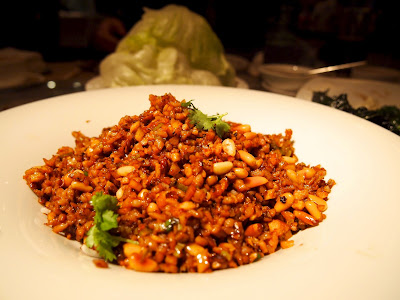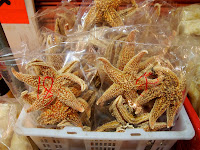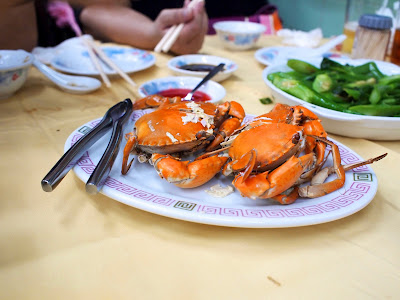skip to main |
skip to sidebar
Ming Court, Mong Kok
Mong Kok is well known for its red light district, street food and outdoor market. Who would think that the Langham Hotel group would open a hotel in this area? Not only has the Langham Place Hotel become one of the landmarks this side of the harbour, its contemporary Chinese restaurant Ming Court has been awarded two Michelin stars for three consecutive years. Two Michelin stars means ‘Excellent cuisine, worth a detour’, and to me Ming Court is definitely worth a detour.
The restaurant is made up of two main dining areas - Ming Sun and Ming Moon. They are both decorated with Chinese fine arts, and walls of Ming Dynasty pottery replicas. In addition to the regular menu, there is also a section of award-winning and signature dishes, featuring some unexpected ingredients such as truffles and cheese. Ming Court is also well known for its extensive selection of wine, and there are more than three hundred bottles of wine stored in the 'Ming Cellar'. Each of the featured dish has a recommended wine, which is rarely seen in a Chinese restaurant.
Moving on to the food...
Stir fried fresh prawns with egg white – A good plate of Chinese fried egg has to be fresh and silky smooth ’嫩滑’, which is hard to achieve using a wok. The chef in Ming Court has showcased this skill in this signature dish. The prawns were shelled, and lightly fried with part of the egg white. The remaining egg white was gently cooked to form several snowy layers, before being placed on top of the prawns to form a wobbly mountain. The prawn heads were deep fried to provide an intense flavour from the brown meat, which was a big contrast to the subtle taste of the eggs and prawns. I loved the idea of the crispy Shiso leaves, where the citrus flavour and saltiness brought the whole dish together beautifully.

Yu Chuan Club, Wan Chai
I adore Yu Chuan, simply because it does the best Sichuan food in Hong Kong. It is a private kitchen hidden away on the first floor of a commercial building in the heart of Wan Chai, just behind the Southron basketball court.
There is something unusual and interesting about this place - I remember phoning to make the reservation, the lady who picked up the phone just said ‘Wei?’ (meaning ‘Hello’) without mentioning the restaurant’s name. I did wonder if I had got the right number for a second. Once I enquired about a reservation, the booking process went pretty smoothly. I also nearly missed the restaurant on my first visit, as the building is on a quiet street with few lights, and there was only a small sign pointing up to the first floor of the building. All of these things made me very curious, and eager to try their food.
I could smell the unique Sichuan peppercorn aroma as soon as I stepped out from the lift. ‘Members only’ was written on the door of the restaurant, but I was never asked to apply. We were greeted by the same lady who I had spoken to on the phone. She patiently explained the menu, and recommended some dishes according to the ingredients which they had been able to buy fresh from Wan Chai market that day.
The menu (available in English) consists of six sections - cold starters, ‘home style’, non-spicy, pickled pepper, fish, and shellfish, each section containing five to thirty dishes. There is a set price of HKD200 per person, the number of cold (涼菜) and main dishes (熱菜) you can order depends on the number of guests. There were thirteen of us, so we were able to choose six cold starters and ten main dishes.
Here are the highlights...
Century eggs - Century eggs are not everyone’s cup of tea, they are preserved in ash, salt and rice, etc (NOT horse urine as some people believe!) for months to develop a distinct alkaline flavour. You may find the dark green egg yolk discouraging, but I just could not fault the rich and creamy texture. You have to try it at least once in your life :) In Yu Chuan, the eggs were served with chopped green and red peppers, spring onions and a drizzle of sesame oil.
Sichuan cold noodles - This mountain of egg noodles was dressed lightly with Sichuan pepper, chilli oil and soy sauce, then topped with a mixture of toasted peanuts, spring onion and plenty of garlic. It was not spicy but slightly numbing, which was the perfect ‘warm up’ before the main dishes arrived.
Husband and wife lung slices - They are actually slices of beef and offal, in fact lung is rarely used these days. I like the combination of the toothsome tripe and the tender beef, which together with the crunchy celery stalks gave this dish a variety of textures.
Pickled green chillies and beef - It had the most normal look, but this could not have been more misleading. My tongue started to burn a few seconds after the first mouthful, giving me just enough time to taste the beef. If you want a challenge, this is the one to order.
Sweet and sour pork - We ordered this dish from the non-spicy section of the menu. Although it was a pleasant break from all the crazy hotness, I could hardly find anything exciting about it. The sauce was a tiny bit too sweet, and there was too much of it.
Ma Po tofu - A powerfully spiced dish made with silky smooth tofu, minced pork, and a sauce made from fermented bean paste, red chillies and Sichuan peppercorns.
Water braised fish - This is always the ‘wow’ dish of a meal in a Sichuan restaurant, there are countless red chillies and Sichuan peppercorns swimming in a large serving bowl. The fish was first poached in a broth, and then placed on top of a bed of Chinese cabbage. The peppercorns and chillies, along with star anise and cinnamon sticks were thrown into almost-boiling vegetable oil to generate an incredible aroma, before pouring into the bowl to serve. It was not as spicy as it looks, but the numbing sensation was insane. The fun part was to avoid the peppercorns when you try to get the fish out of the bowl. Some say the cabbage at the bottom is the best bit, do you dare to try it?
Spicy deep fried chicken with dried red chillies - The volume of the dish looked exactly the same before and after eating as there were so much chilli in it. The chicken pieces were deep fried on the bone until crispy, and although it was a relatively dry dish, the chicken was tender and juicy.
Do not be put off by the oily dishes, the flavour of the spices is infused within the oil, which brings the food to life. Our meal at Yu Chuan was thoroughly enjoyable, we were able to try authentic Sichuan cuisine at a very reasonable price. If you want to try a style of Chinese food which is totally different from the local Cantonese one, this is the place to go.
渝川菜館 Yu Chuan Club, 1st Floor, Hundred City Centre, 7 - 17 Amoy Street, Wan Chai
Peking Garden, Tsim Sha Tsui
Peking duck was one of my favourite dishes as a child. I used to demand my parents ordered it whenever we went to a Chinese restaurant. I loved to see (still do) the duck coming out on a trolley, being carefully sliced, and then arranged in front of us. It was almost like a show in my eyes.
The essence of Peking duck is the crispy skin. Air is pumped between the skin and the flesh of the duck, then boiling water is poured over it to contract the skin. It is coated in maltose syrup, and then dried for at least twenty four hours, before roasting in a cherry wood fire. Traditionally Peking duck is part of a duck feast, where the brain, livers, feet, and the rest of the duck are used to form individual dishes. Restaurants nowadays still offer two or three-way duck dishes to customers.
It annoys me (quite a bit) when people get confused between Crispy Duck and Peking duck. Crispy duck originated in the Sichuan Province in China. The duck is first marinated, steamed for three hours, hung to dry, and then deep fried until the skin is crispy. Unlike in the UK, where the duck is shredded to ‘meat dust’ on a plate, it is cut into portions and reassembled to its original shape to serve. Most of the restaurants in the UK use processed duck so that it is ready to deep fry, the resulting meat is usually dry and tough...
Peking Garden is one of the better restaurants to go for Peking duck in Hong Kong. There are four branches, I particularly like the one in Tsim Sha Tsui, where I found that the duck is a bit better than the branches on Hong Kong island, and the restaurant is (slightly) less touristy.
The waiter skillfully slices the duck skin. This is where the alternative name for this dish came from - 'Pin Pei Ngap' (sliced duck skin).
The fun part of eating Peking duck is you get to DIY - fill your steaming pancakes with fresh cucumber and spring onion slices, then top with Tim Min Jeung (sweet bean sauce). I always sneakily put more than two pieces of duck in one pancake when no one is watching. I never manage to wrap it up properly before putting it into my mouth, so the sauce ends up all over the place. The dripping sauce, together with the crispy skin and tender meat, was absolutely divine.
We also had...
Deep fried spring chicken with garlic crumbs
Stir fried Chinese pea sprouts with mushroom
Fried whole Mandarin fish in sweet and sour pine nut sauce
It was a pleasant dinner highlighted with an outstanding Peking duck, and the show-stopper fried Mandarin fish. The service is a bit hit and miss, I did feel we were being rushed a couple times, even though the restaurant was not full. Another restaurant called ‘Spring Deer’ in Tsim Sha Tsui East also has Peking Duck as one of its signature dishes. I heard the style of the food is more rustic, and the quality is more consistent than Peking Garden. I have already added it to the to-eat list for my next trip home!
北京樓 Peking Garden, 3rd Floor, Star House, 3 Salisbury Road, Tsim Sha Tsui
Tim Ho Wan, Mong Kok
In common with many successful restaurants, Tim Ho Wan did not find success overnight. The man behind it, Chef Mak Kawi Pui, started as a dim sum apprentice when he was just fifteen. He then got promoted to take charge of the dim sum section of a restaurant by the age of twenty. After working his way through various well-known Chinese restaurants in Hong Kong, he was given the title of head dim sum chef by Lung King Hin, which was awarded three Michelin stars while he was working there.
Chef Mak opened the first Tim Ho Wan restaurant in 2009. Moving from a fine dining restaurant to a local cafe hidden in the back streets of Mong Kok, this drastic change made by Chef Mak attracted considerable attention at the time of opening. It was awarded one Michelin star within one year, making it the cheapest Michelin starred restaurant in the world.

Having a no take away, no reservation policy means that you must queue to sample the food. I am not talking about a fifteen minute to half an hour wait - it is TWO hours! We arrived at around half past ten in the morning, and there were already at least thirty people waiting. We got a ‘post-it’ ticket from a lady at the counter outside the restaurant, and we were told that the wait would be around one hour. We then wandered around Mong Kok (I was very tempted to get bubble tea and street food but I managed to restrain myself) for around forty minutes. It must have been my lucky day, as when we were walking back to the restaurant, the lady who gave us the ticket was shouting ‘Table for two? Anyone waiting for table for two?’. So there you go, we got our table within forty five minutes! WIN!

The restaurant is very small, it has less than thirty seats, with the back of your chair right against the person sitting behind you. It is not like having dim sum in a traditional Chinese restaurant on a Sunday with families and friends, you are expected to leave as soon as you finish the meal. There are twenty-six items on the menu (English menu available), including steamed and deep fried dim sum, rice, congee, cheung fun and desserts, all cooked to order.
Baked barbecue pork bun - The restaurant’s best seller, more than seven hundred are sold daily. The sweet bun was soft yet crispy on the outside, filled with a generous amount of roast pork and mouth-watering barbecue sauce.
From left to right - Har Gau (Steamed prawn dumplings), Siu Mai (Steamed pork and prawn dumplings)
Deep fried chive dumplings
Fun Gwoh (Steamed dumplings filled with peanut, chives, mushroom, prawns and pork)
Steamed pig’s liver cheung fun
Satay beef and enoki mushroom spring rolls
Some of the steamed items were not as neat as the ones you can get in larger restaurants, but you could tell they were handmade. I particularly enjoyed the Siu Mai, as they contained large succulent prawns, instead of being minced up like the mass-produced versions. The thickness of the cheung fun was just right, sort of semi transparent, so that you can just about to see the liver inside.
There is no doubt about the quality of the dim sum in Tim Ho Wan, we thoroughly enjoyed our meal, what more can you ask for when you are paying a tenner for seven delicious items? If you are worried about the wait, try the bigger branches in Sham Shui Po and IFC Central. The name ‘Tim Ho Wan’ literally means ‘Enhance Good Luck’, but I do not think they need any more luck, as Chef Mak is planning to open ten more branches in Hong Kong, as well as a new one in Beijing within the next five years.
添好運 Tim Ho Wan, 2-20 Kwong Wa Street, Mong Kok
Lau Fau Shan (流浮山) is a fishing village on the North coast of Hong Kong's New Territories, facing Shenzhen in mainland China. It is traditionally known for its huge harvest of oysters - apparently it used to produce one hundred tons of oysters per year. However, since the village’s younger generations moved away, the oyster harvests have reduced significantly, and now Lau Fau Shan is well known for its street of seafood restaurants. It is rammed with families and tourists during festivals and bank holidays, who come to this little village for the freshest seafood.
The first thing you would notice when arriving at the seafood street is the smell. Along with all the seafood stalls and restaurants, there are shops selling dried foods - oysters, prawns, fish stomachs, duck gizzards, etc. These can be used for making soup, or steamed with rice - even soaked and then used in a stir-fry. Almost any food you name can be found in dried form!
It could be quite confusing for the first timer, as it is pretty hard to work out exactly how much the meal will cost. Most of the restaurants in the seafood street have a very similar pricing system. The total amount you pay includes the price of the seafood, which the restaurants will pay directly to the seafood stall, plus a fee to the restaurant for cooking and service. Do let them know your budget so they can suggest the type and amount of seafood you need. We always go to the stall with the restaurant staff to make sure the seafood they pick is fresh and at reasonable price.
Siu Tao Yuen
We usually go to Siu Tao Yuen when there is a big family gathering. It is one of the bigger restaurants in Lau Feu Shan, which offers private dining rooms and free parking for diners. The food is generally high standard and relatively good value, but the cooking can vary, especially during festivals and weekends.
One of my all time favourites is Mantis prawn - the Cantonese name literally means ‘pissing prawn’, because it shoots water out of its tummy when caught. The mantis prawn is not actually a prawn, it just looks like one. The most common and delicious way of cooking them is frying with chili, salt and pepper. The flesh is sweet, and it has a texture close to lobster or langoustine. The shell is quite hard and it does take years of practice to master the de-shelling process, but once you have reached the meat, you will agree that it was all worthwhile.
We also had...
Sea whelks in spicy rice wine sauce
Steamed abalone with ginger and spring onion
Lobster in Chinese style cheese sauce (see my own version here!)
Deep fried fish belly
小桃園海鮮酒家 Siu Tao Yuen, 28 Ching Tai Street, Lau Fau Shan
Waterside Seafood Restaurant
This is my favourite restaurant in Lau Fau Shan. This family run restaurant may not be as big as Siu Tao Yuen, but it is certainly as busy, and they never disappoint! I usually go with my parents, so we do not need to compete for the big tables with larger family groups. The decor is kind of old-school, I love the paintings on the wall and the retro ceiling fans, I also love to see the old lady (I believe she is the owner) sitting at the front of the restaurant greeting customers.
Moving on to the food...
Fried razor clams in green pepper and black bean sauce - The size of the clams was incredible, each of them was bursting with fresh flavour, I would even eat the shells if they were edible!
Steamed geoduck with vemicelli, garlic and spring onion - Geoduck is a very large clam, it looks a lot like an elephant's trunk so we call it ‘Elephant nose clam’ (Cheung But Pong) in Cantonese. The fishy soy sauce goes very well with rice, so make sure you do not waste it!
Mantis prawn again...
Steamed crabs - The main character of this dish came from the crab roe. Each tiny crab was exploding with roe, I could hardly see any flesh when I split it in half. The roe, almost like a paste, was rich and savoury, which together with the sweetness of the crab meat was heavenly.
Signature fried rice - This is a must-eat dish, it is so popular that I have not seen anyone leaving the restaurant without ordering it. The ingredients include chunks of char siu (roast pork), prawns, egg and spring onion. The rice was moist but not sticky, there was no runny oil left on the plate, which means no excessive oil was used. What a perfect dish to end the meal.
海灣海鮮酒家 Waterside Seafood Restaurant, 44 Ching Tai Street, Lau Fau Shan
Most tourists have only heard of the well known seafood destinations like Sai Kung and Lei Yue Mun, so I hope this post has showed you a bit more about this lovely little spot in the North of Hong Kong. Try to combine a visit to Lau Fau Shan with a trip to the nearby Wetland Park, and then get some traditional wife cakes in Yuen Long. You will not be disappointed!




























































